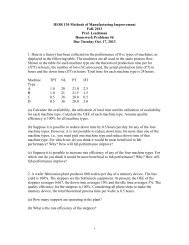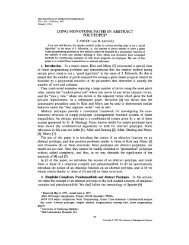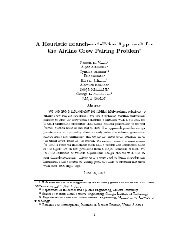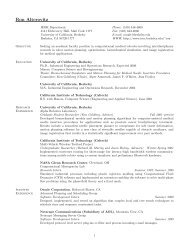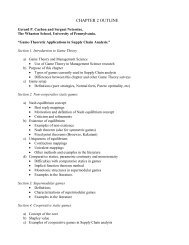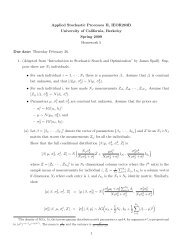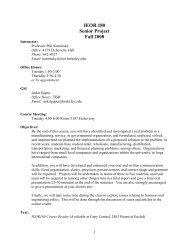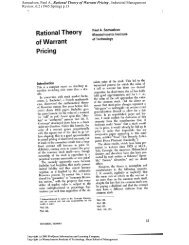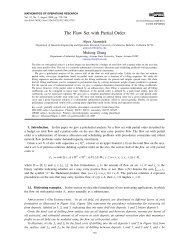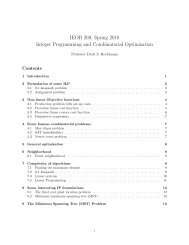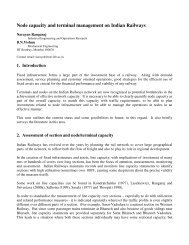A transmission-constrained unit commitment method in ... - CiteSeerX
A transmission-constrained unit commitment method in ... - CiteSeerX
A transmission-constrained unit commitment method in ... - CiteSeerX
Create successful ePaper yourself
Turn your PDF publications into a flip-book with our unique Google optimized e-Paper software.
302<br />
( )<br />
C.-L. Tseng et al.rDecision Support Systems 24 1999 297–310<br />
correspond<strong>in</strong>g to the most unsatisfied capacity constra<strong>in</strong>t and <strong>in</strong>creas<strong>in</strong>g only the multiplier mt<br />
of this hour. This<br />
approach can be modified to simultaneously updat<strong>in</strong>g the multipliers m t’s of it all hours that the sp<strong>in</strong>n<strong>in</strong>g<br />
capacity requirement is violated. Such a modification can speed up the feasibility phase at the cost of<br />
over<strong>commitment</strong> w5,14 x. Under the three-phase scheme, this over<strong>commitment</strong> effect can nevertheless be<br />
corrected <strong>in</strong> the f<strong>in</strong>al <strong>unit</strong> de<strong>commitment</strong> phase to be addressed <strong>in</strong> a later section.<br />
The feasibility phase presented <strong>in</strong> this paper conta<strong>in</strong>s two parts. Part 1 seeks a reserve-feasible <strong>commitment</strong><br />
by <strong>in</strong>creas<strong>in</strong>g the multipliers mt<br />
of all hours with <strong>in</strong>sufficient sp<strong>in</strong>n<strong>in</strong>g capacities. Start<strong>in</strong>g from this reserve-<br />
feasible <strong>commitment</strong> obta<strong>in</strong>ed, Part 2 solves a l<strong>in</strong>ear program Ž LP.<br />
for each hour to verify if this <strong>commitment</strong> is<br />
also dispatchable at this hour. If not, <strong>in</strong>formation can be extracted from the solution of the LP to determ<strong>in</strong>e how<br />
much additional sp<strong>in</strong>n<strong>in</strong>g capacity at this hour is required so that a dispatchable <strong>commitment</strong> exists. The<br />
sp<strong>in</strong>n<strong>in</strong>g reserve requirement of this hour is thus uplift. Part 1 is then rerun with respect to the new Ž uplift.<br />
sp<strong>in</strong>n<strong>in</strong>g reserve requirements. Suppose Part 1 of the feasibility phase term<strong>in</strong>ates at iteration k with an obta<strong>in</strong>ed<br />
<strong>commitment</strong> u k<br />
4<br />
it . Let qbt<br />
be the variable represent<strong>in</strong>g the total generation to be dispatched to bus b <strong>in</strong> time t.<br />
k<br />
4<br />
m<strong>in</strong> m<strong>in</strong> k max max k<br />
Given a <strong>commitment</strong> uit let qbt sÝig L pi uit and qbt sÝig L pi u it, which form an immediate<br />
b<br />
b<br />
lower bound and upper bound for q bt.<br />
ŽLPŽ t..<br />
Ž .<br />
m<strong>in</strong> Ý B y yq max Ž 19.<br />
q bt, ybt<br />
bs1 bt bt<br />
s.t. qbt m<strong>in</strong> FqbtFy bt, ;b Ž 20a.<br />
q max Fy FÝ p max , ;b Ž 20b.<br />
bt bt ig L b i<br />
Ýbs1 B qbtsDt<br />
Ž 20c.<br />
yFlFÝbs1 B G l bŽ qbtyDbt. FF l , ; l Ž 20d.<br />
q Gr D , ;b Ž 20e.<br />
bt bt bt<br />
Ž Ž ..<br />
max<br />
In LP t , y is a variable upper bound of both q and q . Let y ) be the solution of ŽLPŽ t ...Ifu k<br />
4<br />
bt bt bt bt it is<br />
max<br />
dispatchable <strong>in</strong> time t, y )sq solves ŽLPŽ t.. and the optimal objective value of ŽLPŽ t.. is zero. If u k<br />
4<br />
bt bt it is<br />
not dispatchable <strong>in</strong> time t, ŽLPŽ t..<br />
yields a positive objective value, which <strong>in</strong>dicates that to be dispatchable,<br />
more <strong>unit</strong>s should be committed <strong>in</strong> time t, and the target value of the new bus capacity requirement is now<br />
<strong>in</strong>creased to y bt) for each bus b <strong>in</strong> time t. That is, an additional bus sp<strong>in</strong>n<strong>in</strong>g capacity requirement is imposed<br />
to each bus subproblem d Ž P .:<br />
Ý i it bt<br />
b<br />
p max u Gy ). Ž 21.<br />
igL b<br />
Ž .<br />
Part 1 of the feasibility phase is therefore rerun with respect to the updated capacity requirement 21 . The phase<br />
2 algorithm is summarized below.<br />
3.2.1. Phase 2 algorithm<br />
Step 0: k§0; m 0 and r 0 and other multipliers are from Phase 1.<br />
k k<br />
Ž . Ž k k .<br />
Step 1: Given m and r and other multipliers, solve the dual subproblems 14 to obta<strong>in</strong> u , p .<br />
Ž. Ž.<br />
Step 2: If 3 and 6 are satisfied, go to Step 5 if Step 5 has not been visited, otherwise stop.<br />
kq1 k k<br />
Ž<br />
B max k<br />
.<br />
kq1 k k<br />
Step 3: For ;b,t, m §m qs Pm<strong>in</strong> 0, R yÝ Ý p u ; r §r qs Pm<strong>in</strong>Ž<br />
t t t bs1 i g L i it bt bt 0,sbtRbty<br />
b<br />
max<br />
Ý p u k<br />
..<br />
i g L b i it




